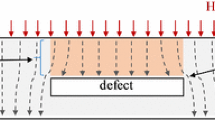Abstract
An approach for treating nondestructive testing as the solution of inverse problems in mathematical physics has been used for the detection of cavities. The approach is developed based on the use of an additional boundary condition of scanned temperature on the surface to solve for the cavity geometry. For the present study, the condition at the cavity side is taken to be that of a specified temperature, and the experiment is carried out to meet this condition. Two specimens are tested in this paper, a plane slab and a rectangular prism. In both bodies the cavity is rectangular in shape. For the testing of the plane slab, the method is able to detect the cavity wall with high accuracy, whereas the cavity depth error is larger (6%). The detection of the cavity position in the rectangular prism has an error ranging from −9.7 to 7.7%. Errors in the experiment are attributed to the uncertainties in the measurements of temperature and the Biot number. The former is read off from the analog data output of the infrared scanner. The latter is not measured separately, but is computed from the scanned data and thus becomes a portion of the total nondestructive testing output. A final note is also made in this paper to relate how the presented method can be used in actual practice.
Similar content being viewed by others
References
E. Wormser, feature editor,Applied Optics 7 (No. 9) (Sept. 1968).
E. A. Farber, C. K. Hsieh, and M. C. K. Yang, Space shuttle thermal protection system condition assessment by thermal radiation analysis techniques, TRL-74-B1, TRL Report, 1974, University of Florida.
C. K. Hsieh, M. C. K. Yang, E. A. Farber, and A. Jorolan, A feasibility study to test structure integrity by infrared scanning technique, inThermal Conductivity, Proceedings of the Fourteenth International Conference on Thermal Conductivity, (Plenum Press, New York, 1975), pp. 521–530.
C. K. Hsieh and W. A. Ellingson, The feasibility of using infrared scanning to test flaws in ceramic materials, inProceedings of the Fifteenth International Conference on Thermal Conductivity (Plenum Press, New York, 1978), pp. 11–22.
C. K. Hsieh and C. M. Thompson, An infrared scanning technique for determination of thermal contact conductance of magnetic substances,Heat Transfer 1974, Vol. 1,Proceedings of the Fifth International Heat Transfer Conference (Japan Society of Mechanical Engineers and Society of Chemical Engineers, Japan, 1974), pp. 152–156.
C. K. Hsieh and X. A. Wang, Measurement of soil thermal conductivity using an infrared scanning technique, inThermal Conductivity 17, (Plenum Press, New York, 1982), to appear.
C. K. Hsieh and X. A. Wang, An infrared scanning technique to measure thermal conductivity of slab materials,Heat Transfer 1982 Munchen, Vol. 4 (Hemisphere Publishing Corp., Washington, 1982), pp. 521–526.
C. Martin and P. Pauchais, Infrared thermography measurement of the emissivity of materials that are good conductors of heat, inThermal Conductivity 17, (Plenum Press, New York, 1982), to appear.
C. K. Hsieh and K. C. Su, A superposition solution of heat conductance in a cavity region subjected to a convective boundary condition, inThermal Conductivity 16 (Plenum Press, New York, 1982), to appear.
C. K. Hsieh and K. C. Su, A methodology of predicting cavity geometry based on the scanned surface temperature data—prescribed surface temperature at the cavity side,J. Heat Transfer 102:324–329 (1980).
C. K. Hsieh and K. C. Su, A methodology of predicting cavity geometry based on the scanned surface temperature data—prescribed heat flux at the cavity side,J. Heat Transfer 103:42–46 (1981).
M. M. Chen, C. O. Pederson, and J. C. Chato, On the feasibility of obtaining three-dimensional information from thermographic measurements,J. Biomed. Eng. 99:58–64 (1977).
E. F. Nogotov,Applications of Numerical Heat Transfer (Hemisphere Publishing Corp., Washington, 1978), pp. 53–55.
F. M. White,Viscous Fluid Flow (McGraw-Hill, New York, 1974), pp. 221–222.
C. K. Hsieh and K. C. Su, Design, construction and analysis of a continuous-temperature infrared calibrator for temperature measurement using an infrared scanner,Rev. Sci. Instrum. 50(7):888–896 (1979).
C. K. Hsieh and W. A. Ellingson, A quantitative determination of surface temperatures using an infrared camera, Proc. Soc. Photo-Optical Instrum. Eng.124:228–235 (1977).
E. Wong, Temperature and spatial resolution analysis for an AGA System 680 infrared scanning system, M.S. thesis, University of Florida (1982).
C. K. Hsieh, W. A. Ellingson and K. C. Su, A model study for quantitative flaw detection using infrared scanning,Bri. J. Nondestr. Testing (1979), pp. 185–192.
Author information
Authors and Affiliations
Rights and permissions
About this article
Cite this article
Hsieh, C.K., Wang, X.A. & Yang, S.L. Infrared scanning thermography for a quantitative detection of cavities in a plane slab and a rectangular prism. J Nondestruct Eval 3, 99–109 (1982). https://doi.org/10.1007/BF00568966
Received:
Issue Date:
DOI: https://doi.org/10.1007/BF00568966




